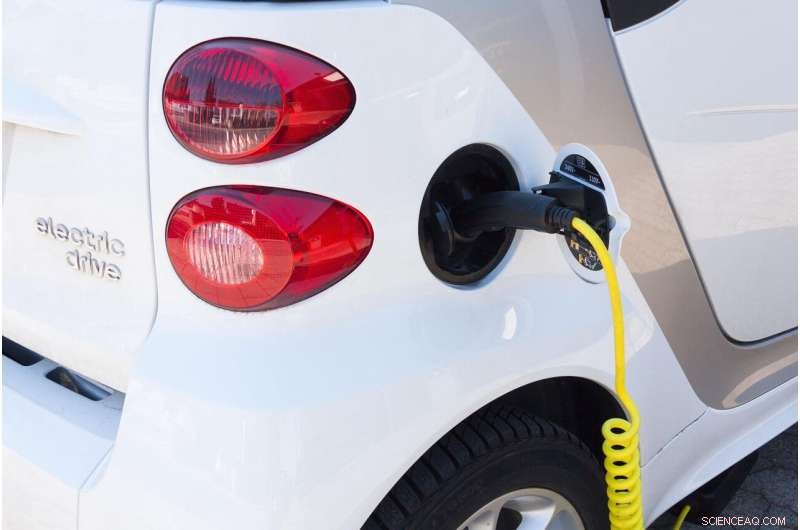Med et forbud mod benzinbiler håber Californien at føre nationen. Kan det levere?

Kredit:Pixabay/CC0 Public Domain
Det var den slags modige, klimafokuserede initiativ, som Californien har udviklet et ry for - et effektivt forbud mod salg af nye benzindrevne biler inden 2035.
Men sidste uges historiske afstemning fra California Air Resources Board følger en række omfattende statslige miljøtiltag, der har haft varierende grader af succes.
Nu, hvor embedsmænd søger at ændre Californiens bilkultur fundamentalt – og derved reducere dens største kilde til kulstofemissioner og luftforurening – siger eksperter, at disse tidligere initiativer kan kaste lys over, hvorvidt Californiens landsførende bilplan kan fungere.
Luftkvalitet og smog
I Los Angeles bliver den tætte smog, der engang kvalte byen, i dag betragtet som folklore. På det værste, mellem 1950'erne og 1980'erne, var den kaustiske dis så tyk, at folk kun kunne se så langt som til en byblok. Det irriterede folks hals og lunger og gav dem blodskudte øjne. Dengang var der mere end 200 dage med usund luft årligt, ifølge Air Resources Board.
Siden dengang har der været enorme fremskridt i retning af at reducere smog og luftforurening, meget af det på grund af renere biler. Mængden af smogdannende nitrogenoxider er blevet reduceret med mere end 50 % i de sidste to årtier, hvilket har forbedret folkesundheden væsentligt.
Men Californiens fremskridt i kampen mod luftforurening er stagneret i de seneste årtier, og staten er stadig hjemsted for den værste luftforurening i landet. Sydkystens luftbassin – Los Angeles, Orange, Riverside og en del af San Bernardino amter – har endnu ikke opfyldt nogen føderale sundhedsstandarder for ozonniveauer, inklusive den ældste foranstaltning, der blev vedtaget i 1979.
"Hvis du ser tilbage 70 år, har vi gjort et vidunderligt stykke arbejde," sagde Joe Lyou, formand for Coalition for Clean Air. "Hvis du ser tilbage på det sidste årti eller to, er det ikke så godt. Og hvis du ser på de juridiske standarder, der kræver, at vi sørger for sund luft, så folk kan trække vejret, så har vi det slet ikke godt."
Global opvarmning har yderligere forværret problemet ved at give næring til skovbrande og forhold, der er mere befordrende for smogdannelse.
"Dage med farlige luftforurening er ude af hitlisterne på grund af væksten i klima-drevne naturbrande," sagde Will Barrett, national seniordirektør for ren luft fortalervirksomhed for American Lung Association. "Vi ved også, at ozon dannes, når udstødningsemissioner og andre emissioner blandes i atmosfæren på varme, solrige dage. Vi ser mere varme, mere ekstreme vejrbegivenheder, der skaber bedre betingelser for dannelsen af ozon og truer sundheden på jorden. Disse er dobbelte kriser. De stammer fra de samme kilder - transportkilder."
Men det var statens evne til at tackle og løse en stor smogkrise, der giver nogle eksperter håb om, at det også kan transformere transporten.
"Air Resources Boards største krav til berømmelse før klimaæraen var dens rolle i at skabe og gennemtvinge vedtagelsen af katalysatorer og andre teknologier for at reducere emissionerne af smogdannende forurening, som kvælede de store storbycentre i både Bay Area og på sydkysten," sagde Danny Cullenward, politisk direktør hos nonprofit-klimaforskningsorganisationen CarbonPlan. "Så Air Resources Board som en institution skar virkelig sine tænder og havde ekstraordinært succes i tidligere årtier med at tackle et massivt problem, der involverede komplicerede teknologier, magtfulde industrier ... og problemer, der påvirkede folks hverdag."
Cap-and-trade
Et af Californiens skelsættende klimaprogrammer, cap-and-trade, blev oprindeligt lanceret i 2006 med det formål at reducere statens drivhusgasemissioner til 1990-niveauer inden 2020. Det overgik forventningerne og nåede faktisk målet fire år før tid.
I 2017 blev programmet genautoriseret med et meget mere ambitiøst mål:at skære ned på drivhusgasemissionerne til 40 % af 1990-niveauet inden 2030. For at nå dertil bruger programmet et system af forureningskreditter, der i det væsentlige lader store kulstofudledere købe og sælge ubrugte kreditter med det formål at holde alle på eller under en vis total.
Eksperter siger, at det kun virkede. Mens programmet er forblevet et nøgleelement i Californiens klimastrategi, faldt emissionerne med omkring 11 % i 2020 – langt fra målet på 40 %. Hvad mere er, det tal tegner sig sandsynligvis for emissionsreduktioner knyttet til starten af COVID-19-pandemien.
"Beviset er ret klart for, at vi ikke er på rette spor for det mål, og afhængigheden af dette program er en stor del af grunden til, at vi ikke er på rette spor," sagde Cullenward.
Talsmand for Air Resources Board, David Clegern, sagde via e-mail, at staten har politikker på plads for at nå sit mål, "men at komme dertil betyder, at der skal ske en samordnet handling for at implementere politikker for at reducere transport, kortlivede klimaforurenende stoffer, elektricitet og andre emissioner til nå 2030."
"Det faktum, at staten nåede sit 2020-mål fire år for tidligt, og succesen med programmer som Low Carbon Fuel Standard og tilføjelsen af nye programmer betyder, at cap-and-trades rolle kan være mindre i fremtiden, men det vil blive evalueret efter udgivelsen af 2020-omfangsplanen senere i år," sagde han. Omfangsplanen er en køreplan for at opnå CO2-neutralitet i staten og opdateres hvert femte år.
Cullenward noted that the cap-and-trade program has some clear parallels to the advanced clean cars rule, including its plan to provide credits to auto manufacturers who sell more electric vehicles than they're required to. However, there are also some key differences that made him more optimistic about the gas car ban's prospects of success.
For one, he said, the Air Resources Board has historically had more strength as a regulator of mobile emission sources (such as cars) than of stationary ones such as factories and power plants, as evidenced by its earlier success with catalytic converters and smog reduction. What's more, while the industries regulated by cap-and-trade are "local, powerful and politically organized," the state has little in the way of combustion engine production.
Fossil fuels
Despite California's green reputation, it remains the seventh-highest oil producing state in the nation, extracting about 358,000 barrels per day, according to state data.
However, oil production has been declining for decades, and the California Geologic Energy Management Division, or CalGEM, reported that "more permits have been issued to plug and permanently seal existing wells than to drill new ones since 2019." The agency issued 564 new well permits in 2021, down from 1,917 in 2020 and 2,665 in 2019.
Some experts said that's not aggressive enough.
"This transition can't happen too slowly, because there is a climate crisis, and there are significant public health impacts on frontline communities," said Bahram Fazeli, director of research and policy at Communities for a Better Environment.
Although there are ambitions to phase out California's oil and gas production completely—most recently, Gov. Gavin Newsom set his sights on 2045—there has yet to be an official deadline such as the one for the gas car ban.
But the state has made some efforts to control or reduce oil production, including a proposed ban on new oil and gas wells within 3,200 feet of homes, schools and healthcare facilities. Newsom last summer also ordered a ban on new permits for hydraulic fracturing, or fracking, beginning in 2024.
"As we move to swiftly decarbonize our transportation sector and create a healthier future for our children, I've made it clear I don't see a role for fracking in that future and, similarly, believe that California needs to move beyond oil," the governor said at the time.
Fazeli noted that a recent study out of the University of Massachusetts Amherst found that achieving that transition by 2045 is feasible in California, though it would require a significant investment:About $138 billion per year, according to the study. But the fossil fuel industry is, by nature, opposed to such an existential threat, Fazeli said, and even passing "common sense" legislation such as the 3,200-foot buffer zone has proven challenging.
"California's economy is not different from other economies—the economy is a fossil fuel economy," he said. "So California is going through this growing pain of, how do we become a clean energy economy? How do we transition from a fossil fuel economy to a clean energy economy, and also provide good paying jobs? That's a key part of the puzzle."
Another part of the puzzle is balance, according to Kyle Meng, an associate professor of environmental economics at the University of California, Santa Barbara.
"When it comes to gasoline, you really need policies to deal with both the demand side—like the new car ban and subsidies for EVs—as well as the supply side, which is the production of oil," he said. "One without the other would lead to unexpected, adverse consequences."
For example, reducing demand without supply could mean California ends up exporting its excess oil, Meng said, while reducing supply too quickly could leave communities that rely on the industry in bad shape. In Kern County, one of the state's top producing regions, oil and gas extraction provide as much as 20% of the area's property tax revenue.
As in other sectors, equity remains a major concern, especially when it comes to the communities suffering the worst effects of oil and gas drilling, Meng said. But when considering the state's climate efforts thus far, he said there has been good progress.
"If you were to tell me that California would hit the state's 2020 greenhouse gas goals back in 2005, I wouldn't have believed it. But California did it," he said. "However, looking forward, the task for this decade is even more ambitious. The big open question is not just whether California can meet its 2030 greenhouse gas goals, but whether those goals are met in a way that doesn't exacerbate existing inequities across the state."
Vehicle miles traveled
Although phasing out gas-powered cars is one of the state's greatest priorities, that alone won't be enough. Driving habits must change, too, if the state expects to achieve carbon neutrality.
The state climate plan depends on motorists driving at least 12% fewer miles by 2030, and no fewer than 22% by 2045.
Since the advent of the automobile and the construction of the highway system, large cities like Los Angeles and San Francisco have become car-centric. Today, around 75% of daily commuting trips consist of one person driving with no passengers—a practice that remains the primary mode of transportation in California.
"Highway building and sprawl go hand in hand," said Susan Handy, a researcher at UC Davis who has studied strategies to reduce automobile dependence. "That's true in California, and it's also true everywhere else. When we built highways, it made it possible to develop farther from city centers than ever before. And now we're in a situation where we've got these sprawling development patterns and it makes it very hard to get around by means other than the car."
As the state's population has risen and more cars are on the road, state officials funded highway construction and expansion to ease congestion, which ironically fostered more driving.
The only major significant decreases in miles driven occur during economic downturns and, recently, with the onset of the COVID-19 pandemic in 2020 as more people have worked remotely. However, driving has rebounded to pre-pandemic levels.
Public policy strategy to reduce driving has historically included gas tax hikes or tolls, which could serve as a deterrent. But the state could do better at investments and incentivizing other forms of transportation like biking and mass transit, Handy said.
Much of California's plans have depended on providing financial incentives to trade in gas-powered cars for zero-emission vehicles. But some state officials have requested the state look into how driving behaviors might change if the state invests more in mass transit.
"I think it's tough, because we're a car culture, right?" Air Resources Board chair Liane Randolph said at a meeting in June. "We know how to help people buy cars. What we don't know is how to help people change the culture so that they are able to ride public transit in a way that's economical and equitable and efficient for them to get to work and to school and wherever they need to go."
Infrastructure
Infrastructure will play a huge role in California's transition away from gas cars, multiple experts said. Charging stations will be needed to help power electric vehicles, and electricity will be needed to power those charging stations, among myriad considerations.
So far, the state has established many goals to help get there, including plans to construct at least 250,000 public vehicle charging stations by the middle of the decade; 10,000 of which should be fast chargers, according to the California Public Utilities Commission. The state also plans to require landlords of multifamily housing units to provide residents with a means to charge electric cars, though those details are still being worked out.
And it's not only personal vehicles that will need the stations, but also the heavy-duty trucks that transport goods throughout the state every day. The twin ports of Los Angeles and Long Beach have the goal of being serviced exclusively by zero-emission trucks by 2035, but they have a long way to go:Only 35 of the 22,000 trucks that serve the port complex are "electric," "battery electric" or "hydrogen fuel cell," according to data from their clean truck program.
Though the state has made efforts to streamline the permit process for charging stations, mapping tools show huge gaps in their locations, particularly in inland Central California and far Northern California.
"We're nowhere close to where we need to be on infrastructure, especially charging infrastructure for electric vehicles, electric trucks, electric buses, electric off-road equipment," said Lyou, of the Coalition for Clean Air. "And it's emerged as the most challenging thing we have to do."
Another part of the problem is that recharging the batteries of electric cars and trucks could also lead to increased greenhouse gas emissions, depending on where that energy is coming from.
"If you're talking about California trying to move its emissions from gasoline cars into EVs, you're talking about probably doubling the amount of electricity demand on the grid," said Meng, of UC Santa Barbara. "Where's that going to come from? You could imagine large utility-scale solar in places like Kern County, but with the laws as they're written now, it's very hard for Kern County to get property tax benefits from a solar farm than it could from oil drilling." + Udforsk yderligere
California phasing out gas vehicles in climate change fight
2022 Los Angeles Times.
Distribueret af Tribune Content Agency, LLC.
 Varme artikler
Varme artikler
-
 Forskere konstruerer organisk solceller ved hjælp af enzymer i papayafrugtKredit:CC0 Public Domain Titandioxid (titania) tynde film er almindeligt anvendt i forskellige typer solceller. De fremstillingsmetoder, der i øjeblikket bruges til at skabe sådanne titaniumoxidfi
Forskere konstruerer organisk solceller ved hjælp af enzymer i papayafrugtKredit:CC0 Public Domain Titandioxid (titania) tynde film er almindeligt anvendt i forskellige typer solceller. De fremstillingsmetoder, der i øjeblikket bruges til at skabe sådanne titaniumoxidfi -
 Facebook undskylder for dataskandale i britiske avisannoncerZuckerberg gentog, at Facebook havde ændret reglerne, så et sådant databrud ikke kunne ske igen. Facebook-chef Mark Zuckerberg udgav helsidesannoncer i næsten alle Storbritanniens nationale aviser
Facebook undskylder for dataskandale i britiske avisannoncerZuckerberg gentog, at Facebook havde ændret reglerne, så et sådant databrud ikke kunne ske igen. Facebook-chef Mark Zuckerberg udgav helsidesannoncer i næsten alle Storbritanniens nationale aviser -
 Havkat hovedstæder? Alaska topper de stater, hvor din online romantik kan være en fidusKredit:CC0 Public Domain Sommerromantik er i luften, og den særlige person, du lige har mødt på et online datingsite eller på sociale medier, virker for god til at være sand. Den sørgelige sandhed
Havkat hovedstæder? Alaska topper de stater, hvor din online romantik kan være en fidusKredit:CC0 Public Domain Sommerromantik er i luften, og den særlige person, du lige har mødt på et online datingsite eller på sociale medier, virker for god til at være sand. Den sørgelige sandhed -
 At lære af fejl og overførbare færdigheder - egenskaberne for en arbejderrobotKredit:CC0 Public Domain Øvelse gør mester – det er et ordsprog, der har hjulpet mennesker med at blive meget fingerfærdige, og nu er det en tilgang, der anvendes til robotter. Dataloger ved Univ
At lære af fejl og overførbare færdigheder - egenskaberne for en arbejderrobotKredit:CC0 Public Domain Øvelse gør mester – det er et ordsprog, der har hjulpet mennesker med at blive meget fingerfærdige, og nu er det en tilgang, der anvendes til robotter. Dataloger ved Univ


